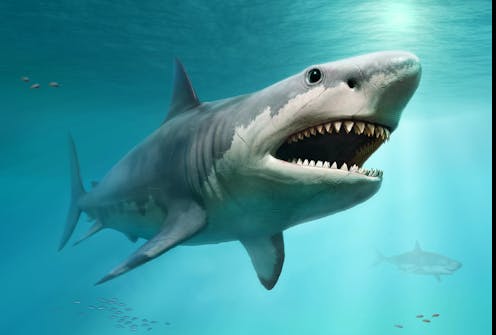Millions of years ago, the megalodon ruled the oceans – why did it disappear?
- Written by Michael Heithaus, Executive Dean of the College of Arts, Sciences & Education and Professor of Biological Sciences, Florida International University

About the megalodon
As a scientist[5] who studies sharks and other ocean species, I am fascinated by the awesome marine predators that have appeared and disappeared through the eons.
That includes huge swimming reptiles like ichthyosaurs[6], plesiosaurs[7] and the mosasaurs[8]. These incredible predators lived during the time of the dinosaurs; megalodon would not appear for another 50 million years.
But when it did arrive on the scene, about 15 million to 20 million years ago, the megalodon must have been an incredible sight.
A fully grown individual weighed about 50 metric tons – that’s more than 110,000 pounds (50,000 kilograms) – and was 50 to 60 feet long (15 to 18 meters). This animal was longer than a school bus and as heavy as a railroad car!
Its jaws were up to 10 feet (3 meters) wide, the teeth up to 7 inches (17.8 centimeters) long and the bite force[9] was 40,000 pounds per square inch (2,800 kilograms per square centimeter).
Not surprisingly, megalodons ate big prey. Scientists know this because they’ve found chips of megalodon teeth embedded in the bones of large marine animals. On the menu, along with whales: large fish, seals, sea lions, dolphins and other sharks.
Are scientists sure megalodon is extinct?
Internet rumors persist that modern-day megalodons exist – that they still swim around in today’s oceans.
But that’s not true. Megalodons are extinct. They died out about 3.5 million years ago.
And scientists know this because, once again, they looked at the teeth. All sharks – including megalodons – produce and ultimately lose tens of thousands of teeth throughout their lives.
That means lots of those lost megalodon teeth are around as fossils[11]. Some are found at the bottom of the ocean; others washed up on shore[12].
But nobody has ever found a megalodon tooth that’s less than 3.5 million years old[13]. That’s one of the reasons scientists believe megalodon went extinct then.
What’s more, megalodons spent much of their time relatively close to shore, a place where they easily found prey.
So if megalodons still existed, people would certainly have seen them. They were way too big to miss; we would have lots of photographs and videos.
Watch this PBS Eons video and learn more about the megalodon shark.Why megalodon disappeared
It probably wasn’t one single thing that led to the extinction of this amazing megapredator, but a complex mix of challenges.
First, the climate dramatically changed. Global water temperature dropped; that reduced the area where megalodon, a warm-water shark, could thrive.
Second, because of the changing climate, entire species that megalodon preyed upon vanished forever.
At the same time, competitors helped push megalodon to extinction – that includes the great white shark[14]. Even though they were only one-third the size of megalodons, the great whites probably ate some of the same prey.
Then there were killer sperm whales[15], a now-extinct type of sperm whale. They grew as large as megalodon and had even bigger teeth. They were also warmblooded; that meant they enjoyed an expanded habitat, because living in cold waters wasn’t a problem.
Killer sperm whales probably traveled in groups, so they had an advantage when encountering a megalodon, which probably hunted alone.
The cooling seas, the disappearance of prey and the competition – it was all too much for the megalodon.
And that’s why you’ll never find a modern-day megalodon tooth.
From NatGeo Kids: What it’s like to be a marine biologist.Hello, curious kids! Do you have a question you’d like an expert to answer? Ask an adult to send your question to CuriousKidsUS@theconversation.com[16]. Please tell us your name, age and the city where you live.
And since curiosity has no age limit – adults, let us know what you’re wondering, too. We won’t be able to answer every question, but we will do our best.
References
- ^ Curious Kids (theconversation.com)
- ^ curiouskidsus@theconversation.com (theconversation.com)
- ^ Otodus megalodon (www.howtopronounce.com)
- ^ Mark Kostich/iStock via Getty Images Plus (www.gettyimages.com)
- ^ As a scientist (case.fiu.edu)
- ^ ichthyosaurs (www.kidsnews.com.au)
- ^ plesiosaurs (theconversation.com)
- ^ mosasaurs (www.livescience.com)
- ^ the bite force (oceanconservancy.org)
- ^ Corey Ford/iStock via Getty Images Plus (www.gettyimages.com)
- ^ are around as fossils (science.lovetoknow.com)
- ^ washed up on shore (www.greatyarmouthmercury.co.uk)
- ^ 3.5 million years old (earthathome.org)
- ^ great white shark (www.livescience.com)
- ^ killer sperm whales (www.earthtouchnews.com)
- ^ CuriousKidsUS@theconversation.com (theconversation.com)
Authors: Michael Heithaus, Executive Dean of the College of Arts, Sciences & Education and Professor of Biological Sciences, Florida International University


